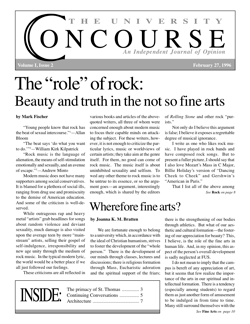Wherefore fine arts?
by Joanna K. M. Bratten
We are fortunate enough to belong to a university which, in accordance with the ideal of Christian humanism, strives to foster the development of the “whole person.” There is the development of our minds through classes, lectures and discussions; there is religious formation through Mass, Eucharistic adoration and the spiritual support of the friars; there is the strengthening of our bodies through athletics. But what of our aesthetic and cultural formation—the fostering of our appreciation for beauty? This, I believe, is the role of the fine arts in human life. And, in my opinion, this aspect of the person’s overall development is sadly neglected at FUS.
I do not mean to imply that the campus is bereft of any appreciation of art, but it seems that few realize the importance of the arts in our spiritual and intellectual formation. There is a tendency (especially among students) to regard them as just another form of amusement to be indulged in from time to time. Many still surround themselves with the “art” of modern pop-culture. Rather than allowing themselves to be formed and inspired by the great music, drama, poetry and artwork of the past several centuries, they choose to wallow in the mediocrity of the music, TV programs, and movies with which society has bombarded us for the past fifty or sixty years. These forms of “art” contribute little to, and often detract from, the overall formation of the person; they offer no real inspiration, solace, or even pure aesthetic pleasure; much less do they bring us closer to what we, as humans made in the image and likeness of God, are intended to be.
Again, I do not claim there is no appreciation of fine arts on our campus. The large majority of the students here are quite aware that the music of Mozart or Brahms is indescribably beautiful, that the poetry or drama of Browning and Shakespeare is noble beyond description, that Rembrandt’s works infinitely surpass those of Andy Warhol or other such artists. However, it seems that most do not allow what they know to become for them an “artistic creed,” so to speak; they do not surround themselves with what they readily acknowledge to be superior to the “art” of pop culture.
Where does the fault lie? Do the students not develop as full an appreciation of the arts as they might because the University does not provide enough opportunity for them to experience the arts? Perhaps. It could also be that the students do not make an effort to support the arts on campus so that, in consequence, artistic events are made less available. This seems to be a rather vicious cycle, and who can say where it begins?
A particularly telling instance of the underdevelopment of the arts here is the fact that the majority of new students each year are not aware that the University has a theater, a chamber orchestra, or even an Art Department. When artistic events are held—whether a concert, lecture, poetry reading or theatrical production—attendance is sadly low, and generally comprised mainly of faculty, staff and their families.
Still more discouraging is the tendency among many students to inappropriately moralize their experience of the arts. For example, a number of individuals found Anathan Theater’s production of Duerrenmatt’s The Visit of the Old Lady last year to be offensive and inappropriate for a Christian university, because it contained some indecorous language and made reference to a case of premarital sex. Although the overall message of the play was highly moral (an indictment of materialism and greed), the immoral elements—artistically placed in juxtaposition with other elements, in order to highlight the truth being presented—were commented upon more than was the overall message.
In a more recent instance, I heard of students complaining about posters promoting an art lecture, because they featured a photograph of a nude sculpture, i.e. Donatello’s David. Some went so far as to tear the posters down, calling them offensive. Such incidents are discouraging, and I dislike dwelling upon them, since they are not, I am thankful to say, the norm. Nevertheless they are prevalent enough that some correction of understanding might be well placed.
How should a Christian approach the arts, with what expectations?
First of all, we cannot expect art to always explicitly represent Christian morality, much less the doctrines of the Church. We must take the work of art as simply that—a work of art—not a profession of faith. A work of art is to be judged primarily according to its aesthetic value, and be permitted to speak for itself. With this in mind we must not too quickly dismiss a given work because it may somehow portray an idea or way of life which is less moral or less lovely than the Christian ideal.
True art presents a unity; it brings some kind of order where there was hitherto chaos. In order to do this, the artist sometimes finds it necessary to portray disorder, perhaps downright evil. We would not ask Milton to extract Lucifer from Paradise Lost, nor would we want to see Richard III without Richard. If a work of art “succeeds” as such, it is because that which is true and beautiful in it overcomes that which is hideous. If a play ends “badly”—if that which is “good” seems overcome by that which is “evil”—this is not necessarily an attempt on the artist’s part to prove something contrary to our Faith. Rather, it may be something like an opportunity for us to deepen our awareness of the tragedy of the human condition. “Bad endings” happen in real life all the time. If we cannot deal with them in fiction, how will we ever learn to deal with them in fact?
The Christian, then, should allow authentic art to provide him with a clearer vision of that Source of all beauty and all truth, namely, our Creator. Of all man’s works, perhaps it is art which best provides a glimpse—however slight and fleeting—into the beatific vision. The beauty and order of Bach’s Magnificat, the sublime exuberance of Beethoven’s Ode to Joy, even the power of the opening movements of Orff’s Carmina Burana are all echoes of a much higher beauty, more perfect joy and an infinitely greater power. The great art of the past centuries, and even that which is still created today, can provide us with a motivation, desire and enthusiasm to forge onward through the trials of temporal life, and can give us a hope of the infinite beauty in the world to come.
So, what then is the role of art for us, as students at a Catholic university who are constantly striving to better ourselves? We should make a concerted effort to support artistic events sponsored by the University, and immerse ourselves in all art which is truly good and beautiful, and which speaks to us of our eternal and transcendent home.
Joanna Bratten is a junior majoring in English Drama


